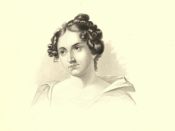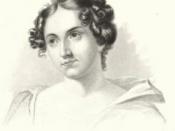In her novel, Hope Leslie, Catharine Maria Sedgwick supplants the importance of strict adherence to religious tenets with the significance the human conscience and following one's own heart. This central theme of the novel is intimated to the reader in the scene where Sir Philip Gardiner, a character that completely defies this ideal, is described. Although he "had a certain erect and gallant bearing that marks a man of the world . . . his dress was strictly puritanical" (124). In other words, even though his demeanor is completely unlike that of a puritan, he adheres to the outward seeming of one. The scene describes in detail these markings and intimations of his person that would indicate an attitude not befitting a puritan. His face suggested the "ravages of the passions" while his constantly roving eyes indicated a "restless mind" (124). The only signs of Sir Philip's "puritanism" are his pretenses and his clothing, and these are enough to convince society he is a religious man, quite a "dandy quaker" (125).
Sir Philip is hailed as "a godly and approved member of the congregation" (152). He is considered such an exemplar of the puritanical faith that he is deemed a more appropriate match for Hope than Everell. While Sir Philip maintains the outward appearances of a puritan, Everell, while his "puritan principles [remain] uncorrupted . . . has little of the outward man of a 'pilgrim indeed'" (150). When Mr. Fletcher asks Winthrop about the validity of Sir Philip's supposed credentials, Winthrop replies "that he thought the gentleman scarcely needed other than he carried in his language and deportment" (155). While Sir Philip's principles are untested and Everell clearly rests on puritanical principles, Sir Philip remains the preferred choice for Hope because he has all of the seeming of...


